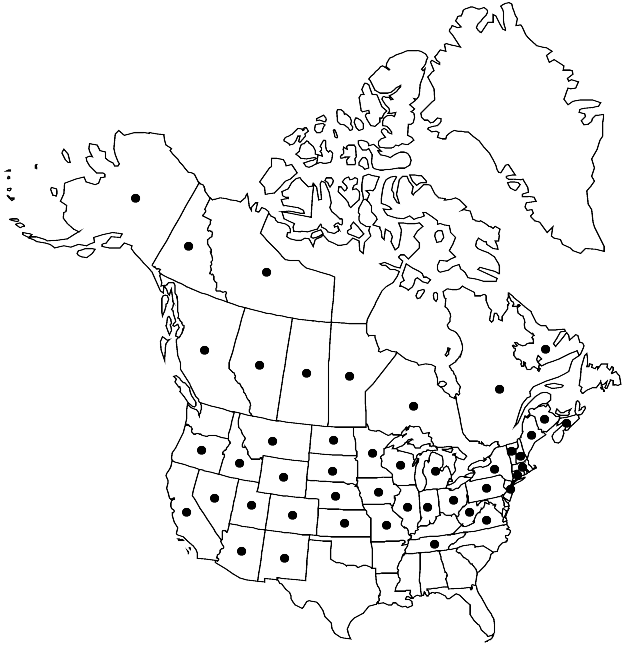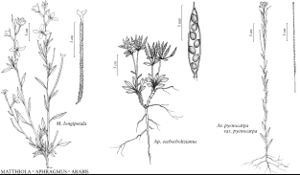Arabis pycnocarpa
Rhodora 39: 112, plate 458, figs. 1–3. 1937.
Biennials or perennials; (caudex branched); usually densely hirsute (at least basally), rarely glabrescent, trichomes simple mixed with stalked or sessile, forked ones. Stems simple or several from base (rosette), erect, often branched distally, 1–8 dm, (pilose with trichomes appressed, malpighiaceous, or minutely stalked, forked, or hirsute basally with trichomes simple and minutely stalked, forked, sometimes almost exclusively pubescent with forked submalpighiaceous trichomes). Basal leaves: petiole 0.5–2 cm, (ciliate or not); blade spatulate, oblanceolate, or oblong, (0.8–)1.5–8 cm × (5–)10–25 mm, margins entire, repand, or dentate, apex obtuse or acute, surfaces sparsely to densely pubescent, trichomes sessile or stalked, simple or forked, and/or stellate. Cauline leaves (7–)10–45(–61), (overlapping or not); blade ovate to oblong or lanceolate, rarely linear, (1–)1.5–6(–8) cm × (1–)3–20(–25) mm, base subcordate or auriculate (auricles obtuse or subacute), margins dentate or entire, apex acute or obtuse, surfaces hirsute or adaxially glabrescent. Racemes often simple. Fruiting pedicels erect to erect-ascending, (2–)3–8(–12) mm (glabrous or sparsely pubescent). Flowers: sepals oblong, 2.5–4 × 0.5–1.5 mm, lateral pair not saccate basally; petals white, linear-oblanceolate or narrowly spatulate, 3.5–5(–5.5) × 1–2(–2.5) mm, apex obtuse; filaments 2.5–4 mm; anthers oblong, 0.7–1 mm. Fruits erect to erect-ascending, (often appressed to rachis), torulose, (3.5–)4–6(–6.5) cm × 0.8–1(–1.2) mm; valves each with obscure or somewhat prominent midvein extending to the middle; ovules (54–)60–86 per ovary; style (0.2–)0.5–1(–1.3) mm, (slender). Seeds narrowly winged throughout, oblong or suborbicular, (0.8–)1–1.5(–1.7) × 0.8–1.3 mm; wing to 0.2 mm wide distally.
Distribution

Alta., B.C., Man., N.B., N.S., N.W.T., Nfld. and Labr., Ont., Que., Sask., Yukon, Alaska, Ariz., Calif., Colo., Conn., Idaho, Ill., Ind., Iowa, Kans., Maine, Mass., Mich., Minn., Mo., Mont., N.Dak., N.H., N.J., N.Mex., N.Y., Nebr., Nev., Ohio, Oreg., Pa., S.Dak., Tenn., Utah, Va., Vt., W.Va., Wis., Wyo., Asia.
Discussion
Varieties 2 (2 in the flora).
M. Hopkins (1937) synthesized earlier works on Arabis pycnocarpa and concluded that it is different from the European A. hirsuta. Both R. C. Rollins (1941, 1993) and G. A. Mulligan (1996) considered the North American and European plants different varieties of A. hirsuta; Mulligan recognized var. hirsuta in North America and Rollins did not. After examining thousands of specimens from Europe, Asia, and North America, I conclude that Hopkins was correct in treating the North American plants as a different species, A. pycnocarpa. The European A. hirsuta is a diploid (2n = 16) that has fruits 1.5–4 cm, stout styles 0.1–0.5 mm, prominent midvein extending the full length of the fruit valve, and 30–40(–44) ovules/seeds per ovary/fruit. By contrast, A. pycnocarpa is a tetraploid (2n = 32) that has fruits (3.5–)4–6(–6.5) cm, often slender styles (0.2–)0.5–1(–1.3) mm, obscure midvein hardly extending to the middle of the fruit valve, and ovules/seeds (54–)60–86 per ovary/fruit. Hopkins listed other differences in the number of cauline leaves and the development of seed wing, but these do not hold. Mulligan treated the perennial North American plants with minute styles as var. hirsuta and the biennial ones with longer styles as var. pycnocarpa. Habit and style length are not correlated at all, and one finds both biennials and perennials flowering in the same population.
Selected References
None.
Key
| 1 | Stems usually hirsute basally, rarely glabrescent, trichomes often simple, sometimes branched; basal leaf blades: surfaces with simple and stalked trichomes. | Arabis pycnocarpa var. pycnocarpa |
| 1 | Stems pilose, trichomes appressed, malpighiaceous, or minutely stalked, forked; basal leaf blades: surfaces with sessile, forked, and/or stellatetrichomes. | Arabis pycnocarpa var. adpressipilis |
